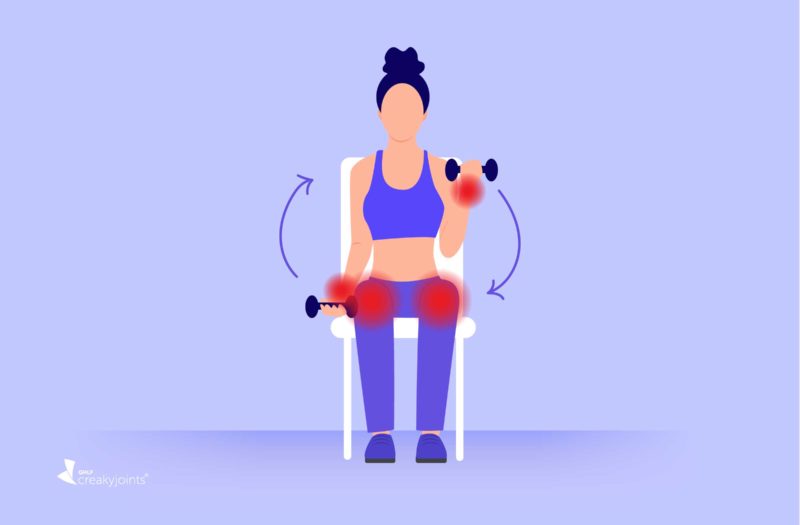Key Takeaways
- New ACR Guideline addresses integrative interventions for rheumatoid arthritis.
- Regular exercise listed as strongest recommendation, yet type frequency, intensity, and duration not yet formally defined.
- Conditional recommendations favor the Mediterranean diet, physical therapy, and massage.
If you have rheumatoid arthritis (RA), you hopefully understand that taking disease-modifying anti-rheumatic drugs (DMARDs) is essential to controlling your condition and protecting your joints from further damage. Should integrative strategies also be part of your treatment plan? A brand-new guideline from the American College of Rheumatology (ACR) says yes, and that exercise is most important.
Integrative medicine, in general, refers to anything that is used as an add-on to conventional treatment such as medication. While many people associate integrative medicine with things like acupuncture and herbal supplements, it also includes lifestyle changes like diet and exercise, in addition to stress reduction techniques and other alternative modalities. The goal is for integrative medicine to incorporate add-ons to traditional Western medicine; it should not aim to replace it.
In the past, integrative medicine has relied heavily on cultural traditions and anecdotal evidence, but that’s changing. More research is being conducted, and mainstream medical groups are starting to take it more seriously, in part because patient demand is so high.
In an effort to provide RA patients and the providers who treat them with science-backed advice on the topic, the ACR recently released their first-ever guideline on integrative treatments.
How the New Guideline Was Developed
To create the new guideline, a literature review team combed through the existing research on a variety of integrative modalities for RA and graded them based on the quality of evidence and drafted recommendations. A Voting Panel, which included health experts as well as a few patients, finalized the recommendations; the Panel also determined whether each one should be deemed “strong” or “conditional,” depending on the level of available evidence.
What the New Guideline Says
The guideline includes 28 recommendations, but only one of those was deemed “strong.” It simply states that people with RA should get regular exercise.
According to an ACR press release, “The type of exercise, frequency, intensity, and duration is not formally defined, but the guideline emphasizes moving regularly. The specific elements of an exercise intervention should be tailored to each patient at the given time in their disease trajectory, considering their capabilities, access, and other health conditions.”
While this broad advice might not seem terribly useful to those wanting a clear playbook, it makes sense in light of the fact that everyone with RA will have different activity-related interests as well as variations in their physical abilities and limitations.
Rheumatologists will probably not be surprised by this recommendation, as there are many known benefits of staying active with arthritis. Whether you have RA or another type of inflammatory arthritis such as psoriatic arthritis (PsA) or ankylosing spondylitis (AS), your doctor has likely discussed the importance of movement to lessen your pain, help keep you mobile, decrease fatigue, and promote better mental health.
Of course, exercising with RA or any other type of arthritis isn’t always easy, and it’s wise to take some precautions to ensure that activity won’t add to your discomfort. To that end, be sure to check with your provider about what’s safe or off-limits for you; you may also want to work with a physical therapist, exercise physiologist, or personal trainer who is well-versed in arthritis. Read “Exercise Is Different for Every Body” to find out how different patients with inflammatory arthritis make exercise work for them.
Conditional Recommendations
The new guideline also includes a number of conditional recommendations. According to the ACR, there is some support in favor of:
- A Mediterranean-style diet
- Aerobic exercise, aquatic exercise, resistance exercise, and mind-body exercise
- Physical therapy and occupational therapy
- Acupuncture and massage
- Splinting, bracing, and/or taping
- Work-related modifications or rehabilitation
Meanwhile, the authors conditionally recommended against:
- Dietary supplements
- Chiropractic therapy
- Electrotherapy
The new guideline on integrative approaches is designed to be used in conjunction with the ACR’s 2021 Guideline for the Treatment of RA, which focuses on medication.
What You Should Know
The most important non-drug “treatment” for RA is regular exercise. If you’re new to exercise or have been recently diagnosed with inflammatory arthritis, talk to your doctor before getting started. Listen to your body and go slow. Find more tips on how to exercise with arthritis here.
Be Part of Research with ArthritisPower
Join CreakyJoints’ patient-centered research registry and participate in voluntary studies about managing arthritis. Learn more and sign up here.
American College of Rheumatology. Integrative RA Treatment Guideline. https://www.rheumatology.org/Portals/0/Files/Integrative-RA-Treatment-Guideline-Summary.pdf.
American College of Rheumatology. Exercise and Arthritis. https://www.rheumatology.org/I-Am-A/Patient-Caregiver/Diseases-Conditions/Living-Well-with-Rheumatic-Disease/Exercise-and-Arthritis.
National Center for Complementary and Integrative Complementary, Alternative, or Integrative Health: What’s In a Name? https://www.nccih.nih.gov/health/complementary-alternative-or-integrative-health-whats-in-a-name.






